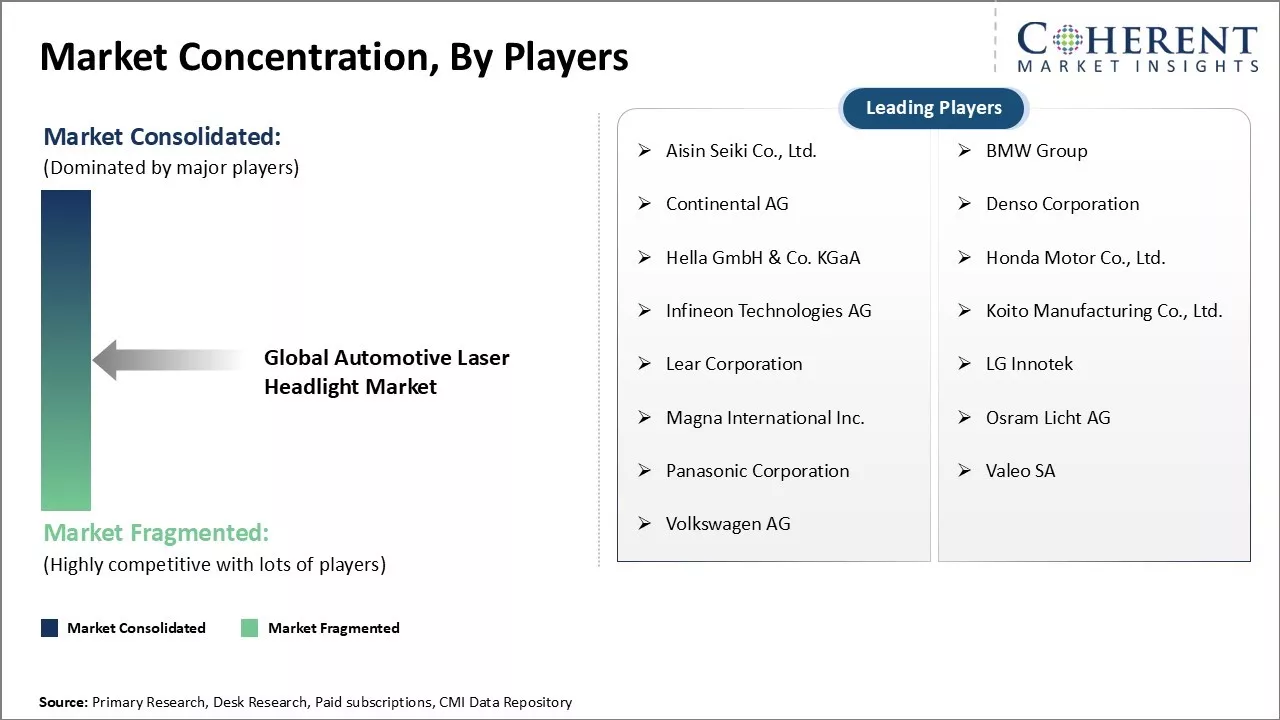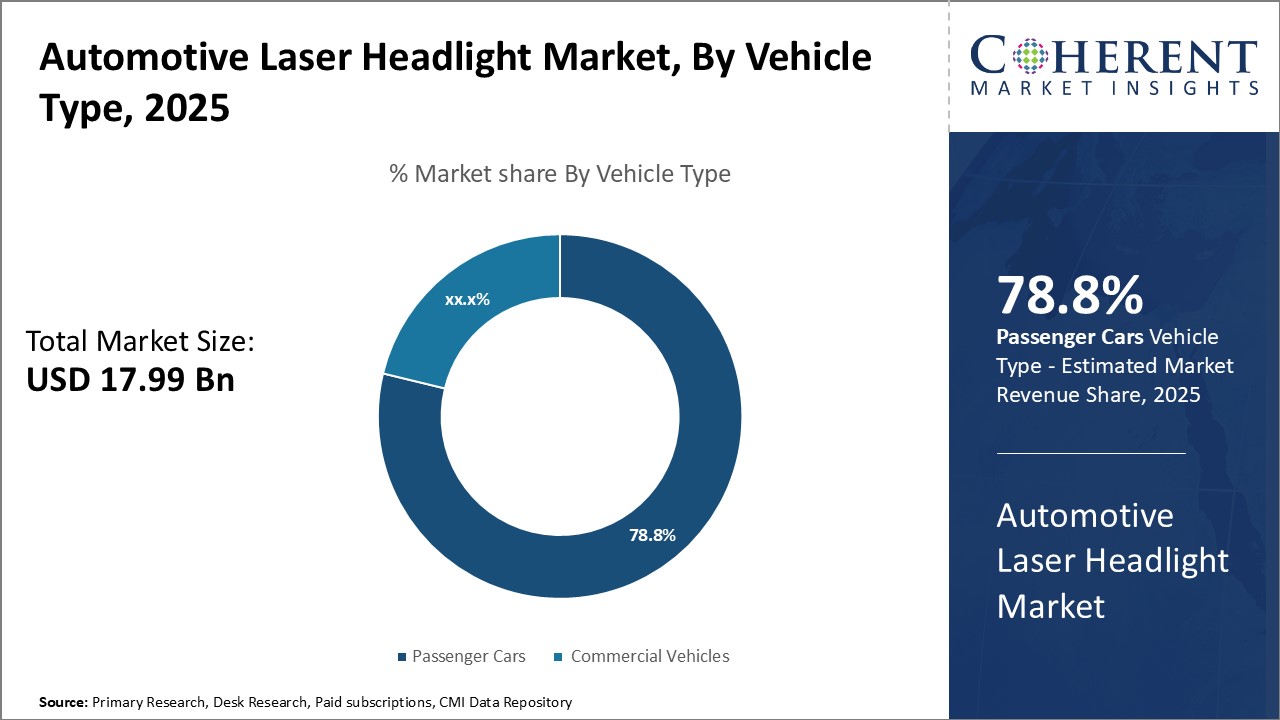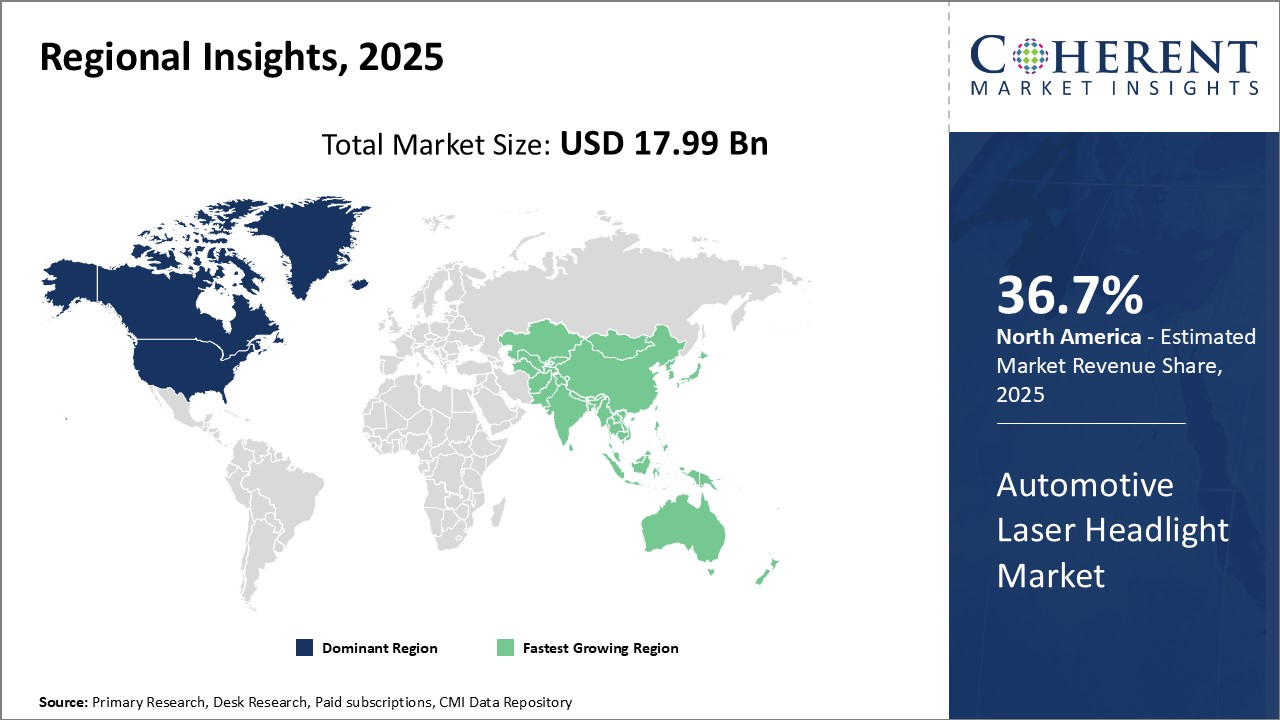The global automotive laser headlight market is estimated to be valued at USD 17.99 Billion in 2025 and is expected to reach USD 92.78 Billion by 2032, exhibiting a compound annual growth rate (CAGR) of 26.4% from 2025 to 2032.

Discover market dynamics shaping the industry: Request sample copy
The transition towards laser headlights is projected to increase over the coming years due to strict regulations regarding headlight performance and vehicle safety.
Market Driver - Increasing demand for advanced safety features in vehicles
As vehicles are getting more advanced with the integration of new technologies, safety has become a major concern for automobile manufacturers as well as customers. With rising road accidents worldwide, there is a heightened focus on introducing advanced driver assistance systems that can help avoid accidents and improve overall vehicle and traffic safety. Laser headlights are one such innovative technology that is gaining more attention from automakers. Unlike traditional headlights that use bulbs for illumination, laser headlights provide higher luminance through a laser diode module which results in a much longer and clearer illumination of the road. This significantly improves driver visibility especially at night or in poorly lit conditions.
The superior illumination from laser headlights allows drivers to spot obstacles from a much farther distance compared to halogen or LED headlights. The ability to better recognize pedestrians, animals, or other vehicles from a longer distance helps drivers react sooner and potentially avoid collisions altogether or at least minimize injuries. This is a big factor considering nighttime accidents account for a large portion of total road accidents globally each year. Automakers are therefore focusing on laser headlights as an important active safety feature that can address this issue of poor visibility, which remains a major cause of accidents even today.
Apart from illumination, laser technology also enables new driver assist functions like high beam assist which automatically dips the high beams around oncoming traffic to avoid blinding other drivers without manual intervention. This enhances overall road safety. Additionally, laser headlight modules are also being developed with integrated functions like adaptive driving beam which scans the road ahead and adjusts illumination according to road conditions and traffic in real time. Such functions based on laser technology offer superior management of light compared to traditional systems. As buyers become more aware of the road safety benefits, there is certainly fast-growing demand especially in developed markets for vehicles equipped with advanced laser headlights.
For instance, in January 2023, KYOCERA SLD Laser, Inc., a pioneer in the commercialization of laser light sources, unveiled the world's first LaserLight Headlight Modules. These cutting-edge modules feature dual illumination in white and infrared (IR), significantly enhancing safety and visibility in automotive applications. The high-brightness white light provides a sharp cutoff, high contrast, and precise beam patterns with minimal glare, maximizing driver visibility. The IR illumination enables improved night vision and enhanced detection of objects such as animals, pedestrians, or other hazards that would otherwise be difficult to see in foggy or dark conditions. The ultra-compact LaserLight Modules have a slim profile with less than a 12.7mm lens height, allowing for flexible installation and configuration options to suit various vehicle designs.

Get actionable strategies to beat competition: Request sample copy
Rising adoption of laser headlights in luxury and premium vehicles
The automobile industry has traditionally seen new vehicle technologies like autonomous drive, electric powertrains, and advanced driver assistance systems introduced first in luxury and premium vehicles before slowly trickling down to mass market segments. Laser headlights are following a similar trend where high-end brands are offering them as differentiating features to attract more affluent buyers who are technology enthusiasts. For premium brands, laser headlights present an opportunity to showcase their technological prowess and cutting-edge innovations. Several luxury nameplates like BMW, Mercedes, and Audi already provide laser headlights as standard or optional equipment on certain high-end trims. This has driven their desire to be at the forefront of automotive lighting technology.
While the initial costs of laser headlight systems are higher than traditional components, premium automakers see it as a future-proof investment. As the technology matures and economies of scale kick in, the costs will reduce over time making laser lights more viable even for mainstream models. By adopting them early, luxury brands are able to gain first-mover advantage and strengthen their image of being the testing ground for new vehicle technologies. This gives them an edge over competitors and helps charge a premium for their vehicles. With affluent buyers becoming more aware of the superior performance attributes of laser headlights like longer illumination, glare-free high beams and adaptive functions, they are showing more preference for premium cars that offer them as standard. This rise in demand perception is driving luxury automakers to adopt laser lights at an increasing pace.
Key Takeaways from Analyst:
The automotive laser headlight market has significant growth potential over the next decade. The rising demand for enhanced safety and superior illumination features in vehicles across the world will drive more automakers to adopt laser headlight technology. Stringent global lighting regulations requiring improved visibility will further push this growth.
As manufacturers focus on integrating advanced technologies to compete, laser headlights will gain wider acceptance in this region. Europe will also see higher demand attributable to the presence of major luxury auto brands and emphasis on technologically advanced vehicle features.
However, high costs associated with laser headlights could hinder faster mass adoption initially. Significant R&D investments and expensive components involved pose challenges for budget-conscious customers and price-sensitive developing markets. Compatibility issues integrating new lighting systems with existing vehicle electronics and designs add another restraint.
Opportunities lie in the ongoing technological advancements that could make laser headlights more affordable and accessible over the coming years. Innovation in manufacturing and materials may lower costs. Increasing collaborations between automakers and lighting equipment suppliers also encourage new solutions. Rising consumer preference for high-end features independent of price could boost the laser headlight market. Overall, as the technology matures, mass market potential seems very probable.
Market Challenges: Limited availability of laser diodes and other essential components
The global automotive laser headlight market is facing challenges due to limited availability of key components such as laser diodes and ultraviolet convertor material. Mass production of laser diodes for automotive applications is still in nascent stages and suppliers are struggling to meet the industry demand. High-power laser diodes that can withstand various environmental conditions inside vehicle headlights require specialized manufacturing processes. This has restricted automakers from widely adopting laser technology in all vehicle segments. Other critical materials like nonlinear crystals that are used by laser diodes to convert infrared laser beam into visible light are also in short supply globally. As automotive-grade laser diodes and ultraviolet convertor components are technologically complex to produce at scale, companies manufacturing these parts are investing heavily in capacity expansion. However, this is likely to take few more years before supply is able to match the demand from automakers and aftermarket segments. The limited and costly availability of laser components is a major roadblock for the high-volume production of laser headlights currently.
Market Opportunities: Growing demand for laser headlights in commercial vehicles and two-wheelers
The automotive laser headlight market is poised to gain significant growth opportunities in the commercial vehicle and two-wheeler segments in the coming years. Laser technology enables brighter and longer illumination compared to traditional headlight bulbs which is especially valuable for commercial vehicles plying on highways during night time. The additional visibility and safety offered by laser headlights can help reduce road accidents involving trucks and buses. Similarly, in the expanding two-wheeler market across developing nations, laser headlights present a compelling value proposition over halogen lights given their compact size and superior night-time visibility without compromising overall vehicle design. Both commercial vehicles and two-wheelers experience high replacement rates for existing headlight solutions, which will drive the aftermarket sales of automotive laser headlights. Leading automakers are actively exploring the feasibility of retrofitting laser technology in these vehicle segments which are expected to be early adopters.

Discover high revenue pocket segments and roadmap to it: Request sample copy
Insights By Vehicle Type - Convenience and Safety Drive the Demand for Passenger Car Laser Headlights
In terms of vehicle type, passenger cars contributes 78.8% share of the global automotive laser headlight market in 2025 owing to convenience and safety factors. Passenger cars need to be equipped with advanced lighting systems to provide optimum visibility to drivers while ensuring safety of other road users. Laser headlights offer superior illumination over long distances compared to conventional headlights systems. They focus the light beam more precisely to maximize illumination of the road ahead without causing glare to oncoming traffic. This allows drivers to spot obstacles from further away, especially at high speeds. The uniform and shadow-less lighting from laser headlights also improves vision in bad weather conditions like fog or heavy rain compared to other technologies. Furthermore, laser headlights consume less energy and have a longer lifetime than LED and halogen headlights. Their compact size allows for stylish integration into modern vehicle designs. As passenger car owners increasingly prioritize safety and comfort features, laser headlight adoption in this segment continues to rise at a steady pace.
Insights By Technology - Emerging Technologies Drive Laser-based Headlight Adoption
In terms of technology, laser-based headlights contributes 42% share of the global automotive laser headlight market in 2025 owing to their superior performance over emerging technologies. While LED-based headlights provide improved illumination compared to conventional halogen bulbs, they cannot match the precision and power of laser diodes. Laser technology emitting coherent invisible light allows for sharper cutoff of light beam and more focused illumination of the road. It also has the potential for advanced lighting functions like dynamic bending light and matrix beam that optimize visibility based on driving scenarios. Automakers are increasingly adopting laser headlights to showcase cutting-edge vehicle design and technology. As laser production costs decline due to mass manufacturing, prices are becoming more competitive against LED options as well. This is driving laser headlights to gain ground over alternative technologies across vehicle segments in the coming years.
Insights By Application - Enhanced visibility and Safety Drive Laser Headlight Adoption for High Beam Function
In terms of application, high beam is expected to contribute 52.6% share of the global automotive laser headlight market in 2025 owing to safety benefits. High beam headlights are crucial for maximizing forward illumination when driving at night or through unlit areas on highways. However, their bright glare can cause oncoming drivers to get blinded. Laser high beams overcome this issue through more focused light projection using invisible light diodes. This allows drivers to use high beams confidently without dazzling others on the road. Laser systems also automatically modulate beams based on presence of other vehicles to prevent glare. The resulting enhanced visibility under all light conditions helps drivers spot obstacles earlier and monitor vehicles ahead clearly for safer driving. Automakers are prioritizing laser headlights for high beam functionality to market safety credentials. As laser options demonstrate superior performance versus halogen and LED bulbs, their popularity for high beam application grows in demand.

Need a Different Region or Segment? Customize now
North America has traditionally dominated the global automotive laser headlight market. The region is expected to hold 36.7% of the market share in 2025. The U.S. is home to the world's major automakers like General Motors, Ford, and Tesla, which are investing heavily in advanced lighting technologies such as laser headlights. These companies see laser headlights as a key differentiator in the premium segments. Laser headlights also offer better illumination compared to LED lights, making them attractive for large vehicles that require powerful headlights for safety.
Major lighting parts manufacturers have a strong presence in the region to cater to demand from automakers as well as aftermarket channels. With the large R&D capabilities of automakers and technology companies, North America will likely continue to lead technology development around laser headlights. Stringent regulations regarding vehicle safety further encourage adoption of advanced lighting systems.
Asia Pacific has emerged as the fastest-growing regional market for automotive laser headlights. Domestic automakers like BYD, Great Wall Motors, and BAIC are aggressively pushing into the premium segments to compete with global brands. Equipping their new luxury models with technologies like laser headlights enables them to gain an edge. Importantly, the overall automotive market in China is massive in size. Even a small percentage increase in adoption of laser headlights can translate into huge volumes, given the number of vehicles sold in China each year.
Localization policies by the Chinese government mandate automakers to source an increasing share of components locally over time. This has encouraged laser headlight manufacturers from Europe and North America to set up production bases in China through joint ventures or acquisitions. In turn, it has made laser headlights more accessible at affordable price points for mid-sized domestic automakers. Strong local production capabilities and a growing demand from automakers are fueling the laser headlight market momentum in China.
Automotive Laser Headlight Market Report Coverage
| Report Coverage | Details | ||
|---|---|---|---|
| Base Year: | 2024 | Market Size in 2025: | USD 17.99 Bn |
| Historical Data for: | 2020 To 2024 | Forecast Period: | 2025 To 2032 |
| Forecast Period 2025 to 2032 CAGR: | 26.4% | 2032 Value Projection: | USD 92.78 Bn |
| Geographies covered: |
|
||
| Segments covered: |
|
||
| Companies covered: |
Aisin Seiki Co., Ltd., BMW Group, Continental AG, Denso Corporation, Hella GmbH & Co. KGaA, Honda Motor Co., Ltd., Infineon Technologies AG, Koito Manufacturing Co., Ltd., Lear Corporation, LG Innotek, Magna International Inc., Osram Licht AG, Panasonic Corporation, Valeo SA, and Volkswagen AG |
||
| Growth Drivers: |
|
||
| Restraints & Challenges: |
|
||
Uncover macros and micros vetted on 75+ parameters: Get instant access to report
*Definition: The global automotive laser headlight market involves automotive headlamps that use laser light instead of xenon or LED lights. Laser headlights offer significant advantages over traditional lighting technologies like directional high beams that do not blind oncoming drivers, improved illumination of the road ahead, and adaptive lighting functions. They provide more bright light on the road while enhancing safety. However, their higher cost compared to LED headlights is currently restricting faster adoption in mass market.
Share
Share
About Author
Ameya Thakkar is a seasoned management consultant with 9+ years of experience optimizing operations and driving growth for companies in the automotive and transportation sector. As a senior consultant at CMI, Ameya has led strategic initiatives that have delivered over $50M in cost savings and revenue gains for clients. Ameya specializes in supply chain optimization, process re-engineering, and identification of deep revenue pockets. He has deep expertise in the automotive industry, having worked with major OEMs and suppliers on complex challenges such as supplier analysis, demand analysis, competitive analysis, and Industry 4.0 implementation.
Missing comfort of reading report in your local language? Find your preferred language :
Transform your Strategy with Exclusive Trending Reports :
Frequently Asked Questions
Joining thousands of companies around the world committed to making the Excellent Business Solutions.
View All Our Clients
US Reciprocal Tax Impact Analysis On Automotive Laser Headlight Market
Stay updated on tariff changes with expert insights and timely information